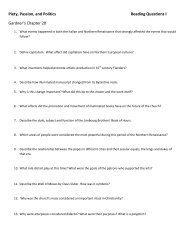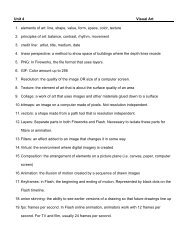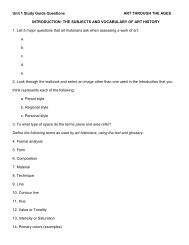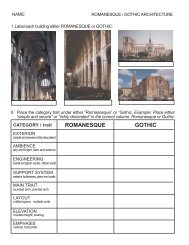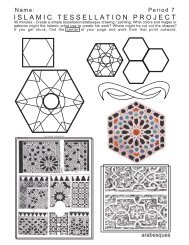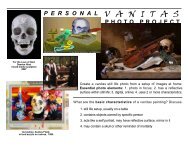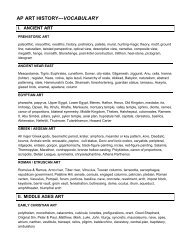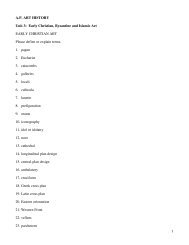Ancient Rome â From Seven Hills to Three Continents ... - Animo Art
Ancient Rome â From Seven Hills to Three Continents ... - Animo Art
Ancient Rome â From Seven Hills to Three Continents ... - Animo Art
Create successful ePaper yourself
Turn your PDF publications into a flip-book with our unique Google optimized e-Paper software.
<strong>Ancient</strong> <strong>Rome</strong> – <strong>From</strong> <strong>Seven</strong> <strong>Hills</strong> <strong>to</strong> <strong>Three</strong> <strong>Continents</strong> – The <strong>Art</strong> of <strong>Ancient</strong> <strong>Rome</strong>Gardner’s Chapter 101. How was <strong>Rome</strong> founded? What century?2. What culture ruled <strong>Rome</strong> prior <strong>to</strong> the Republic? What Greek era was this?3. What was the governing body in the early days of the Roman Republic?4. During a crisis, what figure would be brought forward <strong>to</strong> lead an army or other group?5. What great Carthaginian leader lost <strong>to</strong> the Roman armies?6. Why was the year 211 BCE important?7. What mix of styles was early Roman art and architecture?8. Define eclecticism.9. How is the Temple of Portunus considered eceletic?10. Describe the architectural style tholos. What culture created this style?11. Sketch out:Barrel VaultGroin vaultDome with occulus12. What is verism? Who was a subject of verism?
13. Why was there a demand for verism?14. Compare these portraits <strong>to</strong> the Greek Hellenistic statues.15. What important event was important for the understanding of ancient Roman life?16. What structure is the center of Roman life?17. How is a Roman temple different from a Greek temple?18. Define amphitheater.19. Define the peristyle of a Pompeian villa.20. Define the first style of mural painting.21. Define the second style of mural painting.22. Why was the second style considered important? Which painted villa used this important element?23. Why did these artists paint this way?24. Define the third style of mural painting. Briefly compare this style <strong>to</strong> the second style.25. How did the artists of Roman and Pompeian villas choose their subject?26. How was the fourth style of Pompeian mural painting different from the third style?27. How are the Portrait of husband and wife wall painting different from early paintings?
p. 26528. What event plunged the Roman world in<strong>to</strong> a civil war? How did this event effect the future of the Republic?29. What is the Pax Augusta? What was the cultural result of this?30. How would you describe the portraits of Augustus? What art his<strong>to</strong>ry terms would you use?31. Compare the Doryphoros with the Augustus Primaporta. What was the goal of this Roman portrait?32. What was the function of the Ara Pacis?33. Describe one of the reliefs from the Ara Pacis.34. Which emperor and city was Augustus trying <strong>to</strong> emulate? Why?35. Which temple is an example of Augustus’ neoclassical style? What are the similarities <strong>to</strong> earlier work?36. Which book and by who became the bible of architecture for Renaissance artists?37. What was the function of the aqueduct at Pont-du-Gard? How is the style considered Roman?38. What was another name for the colosseum? Why was it called this?
39. Describe the Roman Colosseum. Why is it considered important?40. What is a triumphal arch? What were “triumphal” arches purposes?41. Describe the two reliefs inside the Arch of Titus. Compare it <strong>to</strong> the Ara Pacis.42. Why was this period considered the “High Empire”?43. List three things that were significant about Trajan.44. What is “felicior Augus<strong>to</strong>, melior Traiano”? Why is this phrase significant?45. What were the purposes of Trajan’s Forum?46. What is a cleres<strong>to</strong>ry? Why is it important?47. Describe Trajan’s Column’s style, subject and significance.48. Compare the Markets of Trajan with a contemporary shopping mall.49. What was the goal / function of the Arch of Trajan?
59. Describe one late motif on late Empire sarcophagi?60. What is the Tetrarchy? Why is it significant?61. Who eventually came out as the leader of the Tetrarchs and why was he considered important?62. Compare the Arch of Constantine with an earlier arch.63. Describe the Portrait of Constantine. How is it different from the Portrait of Caracalla?64. Compare the Basilica Nova with Trajan’s Basilica Ulpia.Conclusion:In Europe, the Middle East, and Africa <strong>to</strong>day, the remains of Roman civilization are everywhere. Roman temples andbasilicas have an afterlife as churches. The powerful concrete vaults of ancient Roman buildings form the cores ofmodern houses, s<strong>to</strong>res, restaurants, fac<strong>to</strong>ries, and museums.Roman civilization also lives on in law and government, in languages, in the calendar-even in the coins used daily.Roman art speaks in a language almost everyone can readily understand. Its diversity and eclecticism foreshadowedthe modern world. The Roman use of art, especially portraits and his<strong>to</strong>rical relief sculptures, <strong>to</strong> manipulate publicopinion is similar <strong>to</strong> the carefully crafted imagery of contemporary political campaigns. And the Roman mastery ofconcrete construction began an architecturally revolution still felt <strong>to</strong>day. Indeed, the Roman Empire is the bridge-inpolitics, the arts and religion-between the ancient and the medieval and modern Western worlds.



